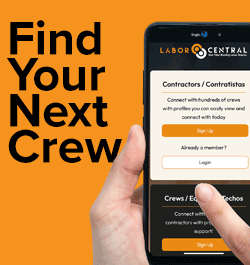Roof Sales 101: The Sales Process

By IKO.
Actionable tips for improving and streamlining your sales process.
Having an efficient and steady sales process is key to consistently and successfully selling roofs. It is always wise to go over these processes and strategize on areas where your sales team can improve. Follow this guide from IKO, which walks you through the entire sales process and strategies to make it go smoother.
The roofing sales process has five main steps: prospecting, qualifying, pitching, closing and following up. Let’s walk through them one by one.
Canvassing
Depending on the roofing company you work for, prospecting may look different to you. You may be canvassing or performing door-to-door sales. In this case, your canvassing process may be looking at which neighborhoods are most likely to need roofing work or which neighborhood your company may want to target. Or you may be cold-calling or following up on leads that your company gets you through marketing initiatives.
Qualifying
Qualifying is all about finding out whether the customer you’re talking to is a good match for the roof that you’re selling. In all sales, there are three basic components to qualifying: pain, budget and authority. Here’s what they look like in the roofing industry in particular:
-
Pain: Does your customer need a new roof or roof repair? Has a storm damaged their roof? Is it old, leaking or perhaps even a poor visual match for their home’s exterior? Sometimes you can reveal to a customer that they need a roof repair or replacement with an inspection, but others may already know they need a new roof.
-
Budget: Does your customer have enough money to afford the roofing they need or the roofing they want? Your company may offer roof financing options that can help you overcome budget hurdles.
-
Authority: Does the specific person you’re speaking to have the authority to make the purchasing decisions for the roof? You may be talking to a renter who doesn’t own the property. Or you may be talking to one member of a couple who doesn’t typically make the purchase decisions. Most salespeople in North America find that the partner who is raising the kids has decision-making power, as he or she spends more time at home. However, it can also be ideal to get both partners together for a sales pitch so that they can confer with each other right away.
How do you find out if your prospect has these three qualities? Right after you introduce yourself and explain why you’re at their door, start asking open-ended questions that can help you find answers as well as build rapport. It isn’t wise to directly ask an uncomfortable question like: “Can you really afford a new roof?” However, people will volunteer information when you get them talking. Options for open-ended questions include:
-
Do you know whether you need a new roof?
-
How did your roof fare after the last storm?
-
Have you noticed any signs that your roof might be aging?
-
When was the last time you had a roof inspection?
-
Have you thought about getting a new roof?
You may start with these questions or with a script that your company has given you. Then, over time, it’s likely that you’ll come up with your own unique questions that feel most genuine coming from you or which are most successful with the individuals that you’re selling to.
The secret to this step is to listen carefully to what the prospect says to you. Some salespeople believe that it is a smart strategy to rush at a customer and get a whole pitch out before they have even listened to a word the prospect has said. You might get more people to reluctantly let you on your roof with this strategy, but, overall, it is less successful and can be a big waste of time.
If someone is not qualified, they will not buy your services. Further, such an aggressive strategy can be off-putting even to those who do need a new roof. If you don’t actively listen to their situation, you will likely lose out on sales because you won’t understand their needs.
Pitching
Once you know that your prospect is qualified, it is time to pitch to them. Pitching is essentially offering your services. You communicate that your company has what the customer needs and the value that these services provide to the customer. There are plenty of different pitching strategies, perhaps even one for every salesperson.
You will probably start with the pitching strategies that your company has taught you. Over time, you’ll learn to present a slightly different pitch based on the information you learned about the prospect in the qualifying stage. You may also develop your own unique strategies to sell in your specific market.
Strategies
We’ll go over some common strategies used to sell roofing below. You’ll need to start some of these strategies right from when you come into contact with the homeowner during the qualifying stage.
-
Zig Ziglar: Zig Ziglar is a famous salesperson who has a tremendous number of classic sales tips to offer. Some of the tips that are most useful for roofing include balancing information and emotion. Too much logic or information and you may struggle to close the sale because people act on emotion. Too much emotion and you’ll close the sale, but the person really isn’t sold on the value of the roof and may feel buyer’s remorse. Establish the value of the roof and use emotion to motivate the prospect to act on that knowledge.
-
LAER: LAER is a bonding process from Carew International. LAER stands for “listen, acknowledge, explore and respond.” In this strategy, when a prospect gives you information, you follow all four steps to build a rapport and get them closer to a close. For example, if a prospect says that they don’t have money for a roof right now, you listen to them. Then, acknowledge their concerns, perhaps by agreeing that roofs are expensive. You can then explore their concerns, asking if they plan on saving money or if they expect to afford the roof some other way down the line. Then, respond by offering your financing options. LAER helps you respond more appropriately and build rapport because the prospect feels acknowledged and that you genuinely care about their concerns. It will help you overcome objections later on.
-
Friendship: This approach is all about being genuine, listening to prospects and treating them as a potential friend and not just a sales goal. Most who use this approach will start by asking the person how their day is going. They’ll give honest information about how their day is going in return. Typically, salespeople who build off friendship have natural charisma and avoid canned lines, feeling out when to naturally transition to talk about roofing.
-
Education: Newer sales tactics are more about educating prospects than building a friendship with them. The internet empowers people to look at the products and services they are considering buying ahead of time. Consumers are used to weighing the pros and cons of different options on their own, and this is true for roofing too. If you can help them with this process by offering truly valuable information that educates them about their roof and not just restate what they found online, then you will earn their trust and their business. For example, if you learn how to spot poor roof design and can educate a customer about that, you can showcase your company’s roofing expertise.
-
Buyer-seller agreements: Many people move through their sales pitch without acknowledging that the prospect is also involved and having a choice about what happens next. Verbally create buyer-seller agreements about what is to happen next. This can be as simple as asking, “Can I show you some shingle samples?” Instead of just pulling them out. Along the same lines, you can ask the customer if they are following what you’re saying, if you’re talking too fast and more.
Learn more about IKO Industries in their RoofersCoffeeShop® Directory or visit www.iko.com
Original article source: IKO






















Comments
Leave a Reply
Have an account? Login to leave a comment!
Sign In